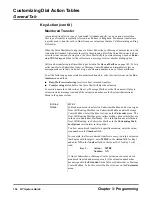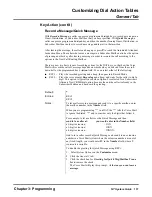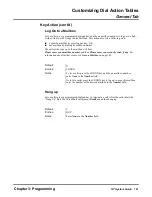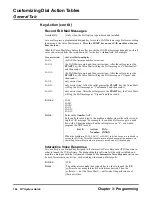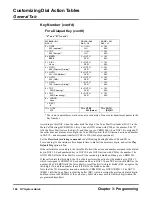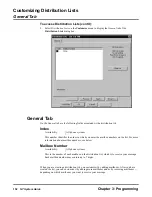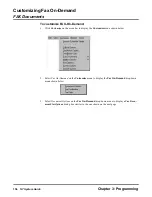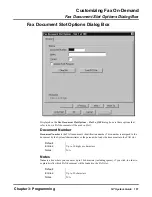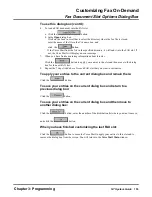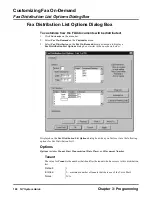
Customizing Dial Action Tables
General Tab
146
NT System Guide
Chapter 3: Programming
Key Number (cont’d)
For a Dialpad Key (cont’d)
“Z” and “R” (cont’d)
* The items in parentheses are shown only as examples. Do not enter department names in the
Key Number.
According to this DAT, when the caller dials the digit 2, the Voice Mail first looks at DAT 1 in the
Main Call Routing (MCRMB) 811. Key 2 has a GOTO action with Z900 as the number. The “Z”
tells the Voice Mail to store the digit (2) and then to go to CRMB 900, where DAT 10 is assigned. If
the caller does not dial any more digits, the Voice Mail looks at the TO (timeout) action and number
in DAT 10: an unscreened transfer (UTRF) to 250 (the Sales department).
Set the Time limit for dialing commands in Call Routing Routing Mailbox 900 and 901 to
2 seconds to give the outside caller adequate time to dial all the necessary digits, and set the Play
Default Msg option to No.
If the caller dials a second digit, the VoiceMail follows the action and number assigned to the dialed
key in DAT 10. Each numbered key in DAT 10 has a GOTO action with Z901as the number. The
GOTO Z901 tells the Voice Mail to store (Z) the second digit dialed and then go to CRMB 901.
If the caller dials the third digit, the Voice Mail performs the action for the dialed key in DAT 11,
which is assigned to CRMB 901. Each numbered key in DAT 11 has a TRF action with RRX as the
number. The TRF RRX tells the Voice Mail to recall the first two digits dialed (RR), recognize the
third digit (X), and then transfer the call (TRF) to the dialed extension.
Note that the TO (timeout) action and number for CRMB 901 are GOTO [RR]811. The GOTO
[RR]811 tells the Voice Mail to clear the buffer [RR], which is storing the previously dialed digits,
and then return to MCRMB 811 the call of any caller who does not dial the third digit within the
programmed time limit.
MCRMB = 811
DAT = 1
CRMB = 900
DAT = 10
CRMB = 901
DAT = 11
0 = UTRF
200 (operator)*
0 = GOTO
Z901
0 = TRF
RRX
1 = TRF
204 (Service)*
1 = GOTO
Z901
1 = TRF
RRX
2 = GOTO
Z900
2 = GOTO
Z901
2 = TRF
RRX
3 = DIRL
None
3 = GOTO
Z901
3 = TRF
RRX
4 = GOTO
400 (Directory Dialing)*
4 = GOTO
Z901
4 = TRF
RRX
5 = GOTO
401 (Q/A Mailbox)*
5 = GOTO
Z901
5 = TRF
RRX
6 = GOTO
402 (UND)
6 = GOTO
Z901
6 = TRF
RRX
7 = GOTO
700 (Directory Dialing)*
7 = GOTO
Z901
7 = TRF
RRX
8 = TRF
350 (Shipping)*
8 = GOTO
Z901
8 = TRF
RRX
9 = TRF
380 (Accounting)*
9 = GOTO
Z901
9 = TRF
RRX
# = LOGON
None
* = REC1
IV
TO = UTRF
300
TO = UTRF
250 (Sales)
TO = GOTO
[RR]811
Summary of Contents for NVM-NT
Page 28: ...Table of Contents Chapter 5 Maintenance xxvi NT System Guide ...
Page 130: ...Installing SMDI 102 NT System Guide Chapter 3 Programming ...
Page 146: ...Customizing Caller I D Tables General Tab 118 NT System Guide Chapter 3 Programming ...
Page 156: ...Customizing Callout Options Optional Tab 128 NT System Guide Chapter 3 Programming ...
Page 182: ...Customizing Distribution Lists General Tab 154 NT System Guide Chapter 3 Programming ...
Page 338: ...Customizing Port Options General Tab 310 NT System Guide Chapter 3 Programming ...
Page 358: ...Customizing System Options Timers Tab 330 NT System Guide Chapter 3 Programming ...
Page 362: ...Customizing System Options Timers Tab 334 NT System Guide Chapter 3 Programming ...
Page 367: ...Customizing Tenant Options General Tab Chapter 3 Programming NT System Guide 339 ...
Page 396: ...Viewing and Printing Reports System Options Report 368 NT System Guide Chapter 3 Programming ...
Page 400: ...Performing a Local Backup Backup Dialog Box 372 NT System Guide Chapter 3 Programming ...
Page 440: ...Using Port Activities 412 NT System Guide Chapter 3 Programming ...
Page 454: ...Using Message Status Message Status Dialog Box 426 NT System Guide Chapter 3 Programming ...



